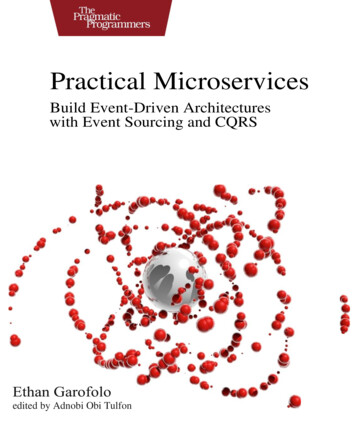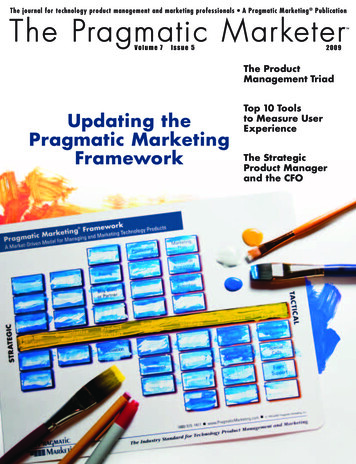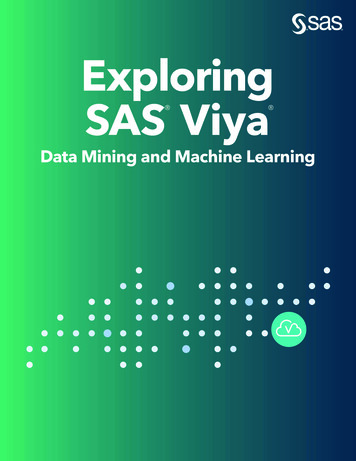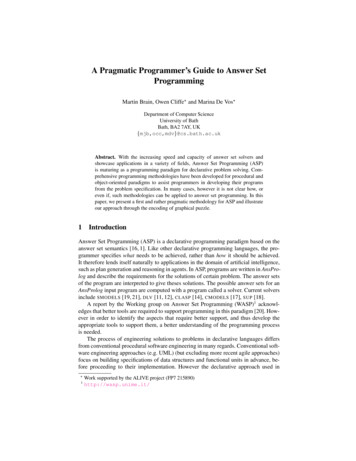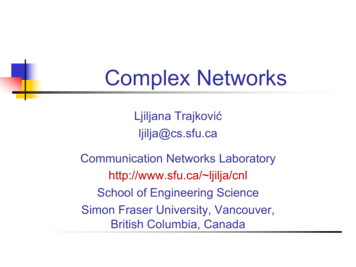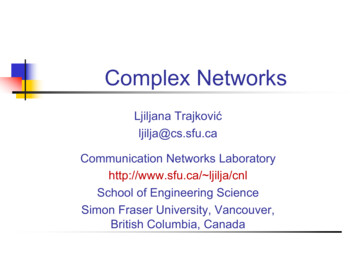
Transcription
Extracted from:Programming Machine LearningFrom Coding to Deep LearningThis PDF file contains pages extracted from Programming Machine Learning,published by the Pragmatic Bookshelf. For more information or to purchase apaperback or PDF copy, please visit http://www.pragprog.com.Note: This extract contains some colored text (particularly in code listing). Thisis available only in online versions of the books. The printed versions are blackand white. Pagination might vary between the online and printed versions; thecontent is otherwise identical.Copyright 2020 The Pragmatic Programmers, LLC.All rights reserved.No part of this publication may be reproduced, stored in a retrieval system, or transmitted,in any form, or by any means, electronic, mechanical, photocopying, recording, or otherwise,without the prior consent of the publisher.The Pragmatic BookshelfRaleigh, North Carolina
Programming Machine LearningFrom Coding to Deep LearningPaolo PerrottaThe Pragmatic BookshelfRaleigh, North Carolina
Many of the designations used by manufacturers and sellers to distinguish their productsare claimed as trademarks. Where those designations appear in this book, and The PragmaticProgrammers, LLC was aware of a trademark claim, the designations have been printed ininitial capital letters or in all capitals. The Pragmatic Starter Kit, The Pragmatic Programmer,Pragmatic Programming, Pragmatic Bookshelf, PragProg and the linking g device are trademarks of The Pragmatic Programmers, LLC.Every precaution was taken in the preparation of this book. However, the publisher assumesno responsibility for errors or omissions, or for damages that may result from the use ofinformation (including program listings) contained herein.For our complete catalog of hands-on, practical, and Pragmatic content for software developers, please visit https://pragprog.com.The team that produced this book includes:Publisher: Andy HuntVP of Operations: Janet FurlowExecutive Editor: Dave RankinDevelopment Editor: Katharine DvorakCopy Editor: Jasmine KwitynIndexing: Potomac Indexing, LLCLayout: Gilson GraphicsFor sales, volume licensing, and support, please contact support@pragprog.com.For international rights, please contact rights@pragprog.com.Copyright 2020 The Pragmatic Programmers, LLC.All rights reserved. No part of this publication may be reproduced, stored in a retrieval system,or transmitted, in any form, or by any means, electronic, mechanical, photocopying, recording,or otherwise, without the prior consent of the publisher.ISBN-13: 978-1-68050-660-0Encoded using the finest acid-free high-entropy binary digits.Book version: P2.0—March 2021
To my wife Irene,making my every day.
How the Heck Is That Possible?Machine learning can seem like magic. How can a computer recognize theobjects in an image? How can a car drive itself?Those feats are baffling—not just to the layman, but to many software developers like you and me. Even after writing code for many years, I had no ideahow machine learning could possibly work. While I tinkered with the latestweb framework, someone out there was writing amazing software that lookedlike science fiction—and I couldn’t even comprehend it.I wanted in on the action. I wanted to be able to build those things myself.I knew how to write software, so I assumed that I would grok machine learningquickly. I mean, how hard could it be? I put on a confident smile and startedstudying. Then I kept smiling confidently as I slammed my muzzle into a longsequence of brick walls.To us developers, machine learning feels foreign. The field is teeming withmath jargon, researchy conventions, and frankly, bad code. Instead of tutorials, people point you at lectures and research papers. For many of us, machinelearning is as intimidating as it’s intriguing.This is the book I missed when I got started with machine learning: an introduction for developers, written in our own language. After reading it, you’ll becomfortable with the fundamentals, and able to write machine learning programs. No, you probably won’t be able to build your own self-driving car justyet—but at least you will know how the heck that’s possible.Come in.About This BookThis is a book for developers who want to learn machine learning from scratch.Machine learning is a broad field, and no book can cover it all. We’ll focus onthe three facets of machine learning that are most important today: supervised Click HERE to purchase this book now. discuss
How the Heck Is That Possible? viiilearning, neural networks, and deep learning. We’ll look into those terms aswe go through the book, but here’s a picture and a few quick definitions toget you started:Supervised learning is a specific type of machine learning. Machine learningcomes in a few different flavors, but supervised learning is the most popularone these days. Part I of this book, From Zero to Image Recognition, is a handson supervised learning tutorial. Within a couple of chapters, we’ll write aminimal learning program. Then we’ll evolve this program step by step, progressively turning it into a machine learning system called a perceptron. Ourperceptron will be a bona fide computer vision program, powerful enough torecognize handwritten characters. We’ll craft it all by ourselves, without usingmachine learning libraries. You’ll understand each single line of its code.There are many ways to implement a supervised learning system. The mostpopular of those is the neural network—a brilliant algorithm that was looselyinspired by the connections of neurons in our own brains. Part II of this bookis dedicated to neural networks. We’ll grow the program from Part I into afull-fledged neural network. We’ll have to overcome a few challenges alongthe way, but the payoff will be worth it: the final neural network will be waymore powerful than the fledgling program we’ll start off with. Once again,we’ll write the code ourselves, line by line. Its inner workings will be open foryou to play with.Neural networks got a big boost in recent years, when researchers came up withbreakthrough techniques to design and use them. This souped-up technology Click HERE to purchase this book now. discuss
Before We Begin ixis vastly more powerful than the simple neural networks of old—so much sothat it got its own name: deep learning. That’s also the title of Part III of thisbook. In it, we’ll rewrite our neural network using a modern machine learninglibrary. The resulting code will be our starting point to understand what deeplearning is about. Finally, as we wrap up the book, we’ll take a look at a fewadvanced deep learning techniques, paving the way for your future explorations.In truth, things aren’t quite as clean-cut as our picture implies. For example,neural networks can be used in other fields of machine learning, not just insupervised learning. However, the diagram just shown is a good starting pointto get a sense of the topics in this book, and how they fit together.Before We BeginThis book cannot turn you into a machine learning pro overnight, but it cangive you an intuitive, practical understanding of how machine learning works.I want to open the hood of this discipline, show you the gears, and demystifythe magic. Once you grasp the fundamental principles of machine learning,you’ll find it much easier to dig deeper, incorporate these techniques in yourdaily job, and maybe even embark on a career as a machine learning engineer.You don’t need to be a senior developer to read this book. However, you shouldbe comfortable writing short programs. If you know Python, then you justlucked out: that’s the language that I will use throughout, so you’ll feel rightat home. Even if you don’t know Python yet, no worries. It’s a friendly language, and the code in this book will never get too complicated. Read Appendix1, Just Enough Python, on page ? to get up to speed, and be ready to Googlefor more information if you get stuck.Machine learning involves a lot of mathematics. I won’t dumb down the math,but I’ll make it as intuitive as I can. To go through this book, you need somehigh school level concepts: I’m going to assume that you can read a Cartesianchart, that you know what the “axes” and their “origin” are, and that you canmake sense of a function plot. Other than that, you don’t need much mathknowledge. In fact, you might be able to read through even if you consideryourself terrible at math But be ready to be proven wrong about that!On the other hand, if you have a solid background in linear algebra and calculus, then you might find some of the math obvious. In that case, feel freeto breeze over the explanations you don’t need. Click HERE to purchase this book now. discuss
How the Heck Is That Possible? xMath Deep DivesWe all love intuitive mathematics, but sometimes you might strivefor a more formal explanation. If you ever feel lost while parsinga formula, or if you like math and want to dig deeper, then lookfor “Math Deep Dive” boxes like this one. They’ll point you at relevant math screencasts on the excellent Khan Academy.1 No matterwhat your current level of math is, this site has got you covered.Just to be clear, these additional lessons are optional. You don’tneed them to read this book—only if you wish to really wrap yourmind around the mathematics of machine learning.Machine learning has a rich and specific vocabulary. You’re likely to stumbleupon new words, or new meanings for old words. Take it easy and don’t feellike you have to remember everything. I will remind you of many of thosewords’ meaning the next time we encounter them. Whenever a term gives youthat obnoxious “I cannot quite remember what this means” feeling, you canlook it up in Appendix 2, The Words of Machine Learning, on page ?.One word about the datasets that I’ll use in the examples: many of them arecollections of images. Rest assured that machine learning can do much morebesides image recognition: it can analyze text, generate music, or even holdconversations. However, image recognition makes for very intuitive examples,so it will be our go-to application throughout the book.Finally, there are a couple of online resources that you should know about.One is this book’s official page2 on the Pragmatic Bookshelf. From there, youcan download the examples’ source code and report errata—typos, bugs, andfactual mistakes.This book also has a companion website called ProgML3 that contains a fewadditional explanations that I couldn’t fit in these pages.References to ProgML lookEvery now and then, you’ll find references to ProgML in thepage margins, pointing you at those optional explanations. like this.Go read them if you’re eager for more details.That’s enough public service announcements. Let’s dive into Part com Click HERE to purchase this book now. discuss
Supervised learning is a specific type of machine learning. Machine learning comes in a few different flavors, but supervised learning is the most popular one these days. Part I of this book, From Zero to Image Recognition, is a hands-on supervised learning tutorial. Within a couple of chapters,


